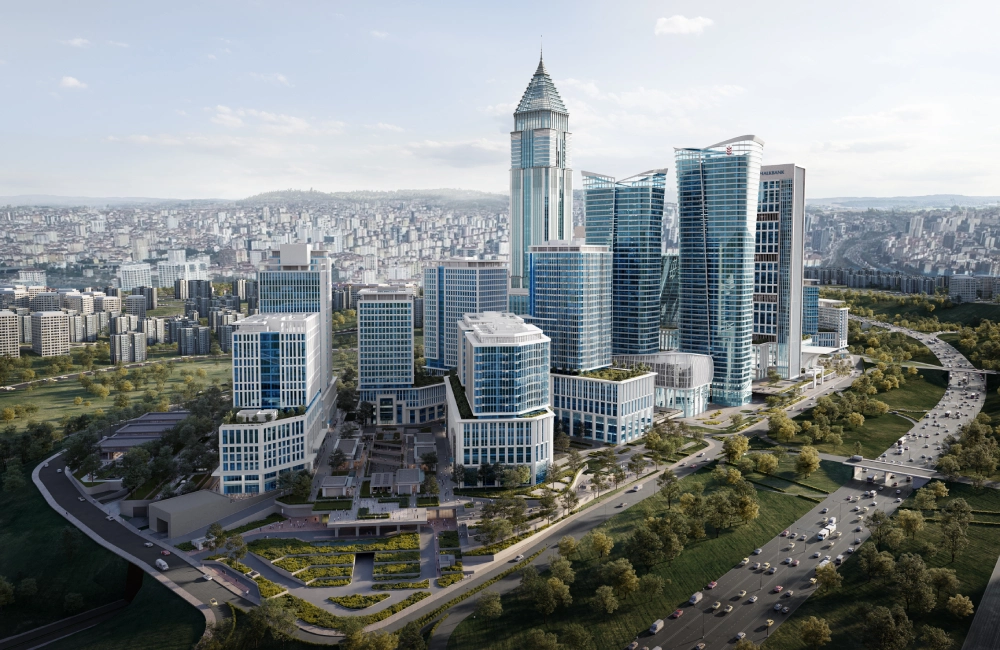Istanbul Financial Center: Unified Security at National Scale
The Istanbul Financial Center in Ataşehir, Istanbul, brings together Turkey’s top financial institutions in 16 high-rise buildings across more than 1.3 million square meters. The challenge was unifying thousands of fragmented security and low-voltage systems into one platform. With Axxon One’s distributed architecture, the IFC gained centralized monitoring, proactive AI analytics, and built-in system health monitoring — creating a resilient, scalable public safety solution to protect one of the country’s most critical financial hubs.
About the Project
The Istanbul Financial Center (IFC) is not just another office park. It’s one of the biggest infrastructure projects in Turkey, designed to bring the country’s financial sector under one roof. Located in Ataşehir, on Istanbul’s Asian side, it houses the Central Bank, public and private banks, and regulatory bodies like the Banking Regulation and Supervision Agency. Alongside finance, there’s also a shopping mall, a 26,000 m² congress center, and landscaped public areas that make it feel like a city within a city.
The numbers give a sense of the challenge: 1.3 million square meters of office space, 100,000 square meters of retail, parking for 25,000 vehicles, and 16 towers built by different contractors. Each building came with its own brand of cameras, alarms, and access control systems. On paper, that meant security. In practice, it meant fragmentation and silos.
The Challenge: Building a Unified Public Safety Solution
With so many contractors, each tower delivered its own “local” solution — different brands, different standards, no central oversight. Some used NVR-based setups just to record video, others had proprietary fire alarm software. For the IFC management, this wasn’t sustainable. There was no way to monitor the entire site from one place, and no consistency in how alarms or incidents were handled.
The requirement was clear: unify everything into a central security and public safety solution. The system had to bring together cameras, fire alarms, access control, and intercoms into a single view. And it had to scale. This wasn’t about a one-time deployment, but about building an infrastructure that would last decades and expand as the site grew.
Another point, often overlooked, was reliability. With thousands of devices in play, failures were inevitable. So, IFC asked for distributed architecture with health monitoring to ensure that problems could be detected early and didn’t take down critical functions.
Selecting AxxonSoft
When evaluating options, IFC compared AxxonSoft with all the main competitors. All could manage video, but IFC needed something more — a platform that could unify thousands of devices from different contractors and still stay reliable at scale. What convinced them was Axxon One’s distributed architecture. Instead of relying on a single central server that could become a bottleneck, the system spreads the load across multiple hubs. This design not only improves resilience but also allows IFC to add capacity as the campus grows, without reworking the entire setup. Coupled with lifetime software updates and predictable licensing, the total cost of ownership was also lower than the alternatives. The final edge came from analytics like Similarity Search, which gave operators tools to work faster and more accurately, not just more public safety cameras to watch.
Decision-makers visited live reference sites in Middle East, including hotels and law enforcement projects running on AxxonSoft. They also saw pilot installations at IFC itself, where the software was tested with the existing mix of cameras and sensors. These demonstrations built confidence that Axxon One could actually integrate many subsystems and not just replace them. And cost mattered. IFC compared long-term licensing models and saw the impact of lifetime software updates and predictable pricing, which contrasted with the subscription-heavy models of competitors.

Implementation at Scale
Rolling out the platform was no small task. Roughly 6,000 cameras were tied into the system, from vendors including Hanwha Techwin, Pelco, Honeywell, and Dahua. About 90,000 fire sensors were integrated through a software-to-software plugin with Mavili, enabling real-time alarm-to-video linking. This integration later grew into a broader partnership between AxxonSoft and Mavili.
Access control systems from Vanderbilt and Honeywell were also pulled into the platform. Now, instead of operators switching between multiple systems, everything could be managed from a single environment. Axxon One’s distributed architecture allowed for multiple monitoring centers, ensuring resilience if one hub went down. Health monitoring functions kept track of server loads, camera statuses, and alarm connections, so small problems could be fixed before they became big ones.
On top of this backbone, analytics played a practical role. License plate recognition helped manage vehicle flows in and out of the campus. Perimeter and intrusion detection improved outdoor security. AI-based proactive monitoring helped reduce false alarms, allowing operators to focus on what mattered. And Similarity Search became a favorite feature making it possible to find a person across thousands of hours of footage in minutes.
Results and Benefits of the Public Safety Solution
The IFC security team went from managing dozens of incompatible systems to one unified platform. Operators in different centers now see the same picture of the site. They can respond faster because alerts are centralized and backed by analytics, rather than relying on scattered local alarms.
The effect on operations is tangible. Investigations that once took hours can now be resolved in minutes with Similarity Search. Health monitoring reduces downtime because teams know about failures before they cascade. And overall, workflows have become simpler. Security personnel spend less time fighting technology and more time focusing on prevention and response.
The platform is also future-ready. IFC is already planning for a 30 percent expansion in capacity over the next five years. Because of the distributed architecture, adding more public safety cameras. devices and monitoring hubs won’t require replacing the system — just extending it. That’s the kind of long-term sustainability the project demanded.







